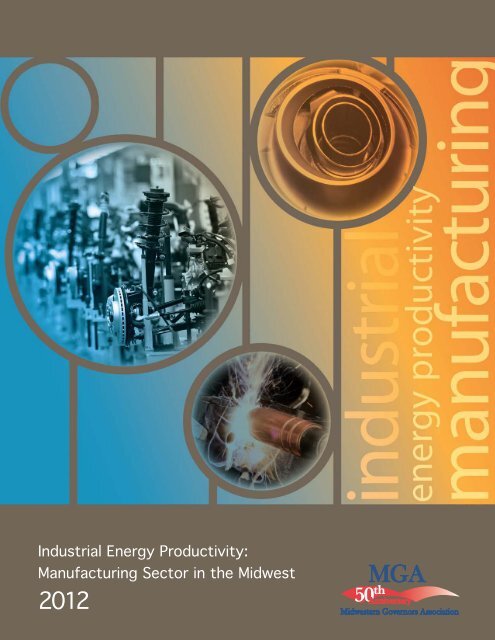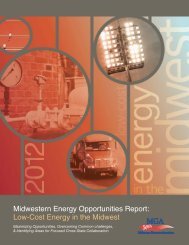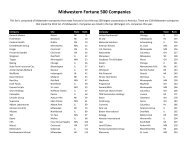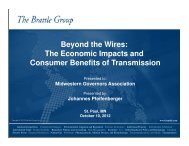Industrial Energy Productivity: Manufacturing Sector in the Midwest
Industrial Energy Productivity: Manufacturing Sector in the Midwest
Industrial Energy Productivity: Manufacturing Sector in the Midwest
You also want an ePaper? Increase the reach of your titles
YUMPU automatically turns print PDFs into web optimized ePapers that Google loves.
<strong>Industrial</strong> <strong>Energy</strong> <strong>Productivity</strong>:<br />
<strong>Manufactur<strong>in</strong>g</strong> <strong>Sector</strong> <strong>in</strong> <strong>the</strong> <strong>Midwest</strong><br />
2012 50 th<br />
Anniversary
Table of Contents<br />
Introduction 1<br />
What is <strong>Industrial</strong> <strong>Energy</strong> <strong>Productivity</strong> 2<br />
Why is IEP Important 3<br />
What Technologies are Utilized <strong>in</strong> IEP Projects 5<br />
What is <strong>the</strong> Scope of <strong>the</strong> IEP <strong>Manufactur<strong>in</strong>g</strong> <strong>Sector</strong> <strong>in</strong> <strong>the</strong> <strong>Midwest</strong> 6<br />
Profiles of <strong>Midwest</strong>ern Companies <strong>in</strong> <strong>the</strong> IEP <strong>Manufactur<strong>in</strong>g</strong> <strong>Sector</strong> 11
Introduction<br />
The <strong>Midwest</strong> accounts for nearly one-fourth of <strong>the</strong> <strong>in</strong>dustrial energy usage <strong>in</strong> <strong>the</strong> U.S., <strong>in</strong>clud<strong>in</strong>g<br />
nearly half of all <strong>in</strong>dustrial coal consumption 1 . Yet, only 10 percent of <strong>Midwest</strong>ern <strong>in</strong>dustrial facilities<br />
are upgrad<strong>in</strong>g <strong>the</strong>ir equipment to improve energy productivity 2 .<br />
With this <strong>in</strong> m<strong>in</strong>d, <strong>in</strong> 2011 <strong>the</strong> <strong>Midwest</strong>ern Governors Association (MGA) launched an <strong>in</strong>dustrial<br />
energy productivity (IEP) <strong>in</strong>itiative aimed at improv<strong>in</strong>g <strong>the</strong> competitiveness of <strong>Midwest</strong>ern <strong>in</strong>dustry<br />
by highlight<strong>in</strong>g <strong>the</strong> region’s IEP assets and opportunities—namely <strong>the</strong> region’s energy,<br />
manufactur<strong>in</strong>g, f<strong>in</strong>ancial, natural and human resources.<br />
As a region, we have a unique opportunity to work cooperatively to:<br />
• promote <strong>the</strong> benefits of improved IEP;<br />
• remove policy and regulatory barriers to IEP; and<br />
• identify new strategies for <strong>in</strong>creas<strong>in</strong>g <strong>the</strong> adoption rate of IEP practices and improvements.<br />
Many government agencies, utilities, universities and nonprofit organizations are beg<strong>in</strong>n<strong>in</strong>g to focus<br />
on untapped opportunities to make <strong>Midwest</strong>ern manufactur<strong>in</strong>g more competitive through improved<br />
energy productivity.<br />
The attention, visibility and cache that a collaboration by <strong>Midwest</strong>ern Governors, legislators and<br />
agency heads br<strong>in</strong>gs, can <strong>in</strong>crease <strong>the</strong> rate of IEP adoption and prevent <strong>the</strong> expense and<br />
<strong>in</strong>efficiency of each state travel<strong>in</strong>g <strong>the</strong> IEP learn<strong>in</strong>g curve alone.<br />
Numerous reports have been published on <strong>the</strong> efforts of large, energy-<strong>in</strong>tensive <strong>in</strong>dustries to make<br />
<strong>the</strong>ir operations more energy productive.<br />
This brief<strong>in</strong>g focuses on manufactur<strong>in</strong>g companies that make and supply <strong>the</strong> <strong>in</strong>novative<br />
technologies and components that are purchased and <strong>in</strong>stalled by large energy users to make <strong>the</strong>ir<br />
operations more efficient. It aims to:<br />
• give state and local policy makers and economic developers a snapshot of <strong>the</strong> manufactur<strong>in</strong>g<br />
sector for IEP <strong>in</strong> <strong>the</strong> region;<br />
• expla<strong>in</strong> what IEP is and what <strong>the</strong> IEP manufactur<strong>in</strong>g sector is;<br />
• highlight why IEP and <strong>the</strong> IEP manufactur<strong>in</strong>g sector is important to <strong>the</strong> <strong>Midwest</strong> and outl<strong>in</strong>e<br />
some of <strong>the</strong> major IEP technologies and components; and<br />
• highlight a small handful of <strong>Midwest</strong> manufactur<strong>in</strong>g companies that are thriv<strong>in</strong>g <strong>in</strong> <strong>the</strong> IEP<br />
marketplace.<br />
1<br />
<strong>Midwest</strong> <strong>Energy</strong> Efficiency Alliance (MEEA), US DOE Web<strong>in</strong>ar, “Regional <strong>Energy</strong> Efficiency Programs”, Dec.13, 2011.<br />
2<br />
2006 <strong>Manufactur<strong>in</strong>g</strong> <strong>Energy</strong> Consumption Survey (MECS Survey), U.S. Census.<br />
1
What is <strong>Industrial</strong> <strong>Energy</strong> <strong>Productivity</strong><br />
There are numerous def<strong>in</strong>itions of <strong>in</strong>dustrial energy productivity (IEP). Some def<strong>in</strong>itions, such as<br />
those used by <strong>the</strong> U.S. <strong>Energy</strong> Information Adm<strong>in</strong>istration (EIA) and <strong>the</strong> Federal Reserve Board’s<br />
Index of <strong>Industrial</strong> Production, are geared toward measur<strong>in</strong>g <strong>the</strong> aggregate and average efficiency<br />
of <strong>in</strong>dustrial enterprises. The EIA also uses a more broadly applicable def<strong>in</strong>ition of energy efficiency<br />
as “energy reductions without sacrifice of service 3 .”<br />
In this report, we use <strong>the</strong> follow<strong>in</strong>g def<strong>in</strong>ition of IEP, which takes EIA’s broader def<strong>in</strong>ition and applies<br />
it to <strong>the</strong> most energy-<strong>in</strong>tensive <strong>in</strong>dustrial sectors <strong>in</strong> <strong>the</strong> U.S. and <strong>in</strong> <strong>the</strong> states that comprise <strong>the</strong><br />
MGA:<br />
IEP is <strong>the</strong> comb<strong>in</strong>ed set of practices (production processes, material sourc<strong>in</strong>g) and<br />
improvements (equipment, mach<strong>in</strong>ery, facilities/build<strong>in</strong>gs) that enable <strong>the</strong> largest, most energy<strong>in</strong>tensive<br />
<strong>in</strong>dustrial enterprises to:<br />
• significantly reduce energy usage and emissions (carbon and particulate),<br />
• significantly reduce energy costs, and<br />
• ma<strong>in</strong>ta<strong>in</strong> or <strong>in</strong>crease production and productivity levels (i.e., no sacrifice of service).<br />
In <strong>the</strong> <strong>Midwest</strong>, <strong>the</strong> most energy-<strong>in</strong>tensive <strong>in</strong>dustries <strong>in</strong>clude petroleum, coal, steel, alum<strong>in</strong>um,<br />
paper and <strong>the</strong> manufactur<strong>in</strong>g of chemicals, mach<strong>in</strong>ery, food and transportation equipment 4 .<br />
3<br />
EIA, Total <strong>Energy</strong>, glossary: http://www.eia.gov/tools/glossary/<strong>in</strong>dex.cfmid=E.<br />
4<br />
Composite list taken from multiple sources <strong>in</strong>clud<strong>in</strong>g Michigan <strong>Manufactur<strong>in</strong>g</strong> Technology Center, World Resources Institute, M<strong>in</strong>nesota Technical<br />
Assistance Program, Center on Globalization & Competitiveness (Duke University), <strong>Midwest</strong> <strong>Energy</strong> Efficiency Alliance, and <strong>the</strong> National<br />
Commission on <strong>Energy</strong> Policy (Yudken).<br />
2
Why is IEP Important<br />
Industry <strong>in</strong> <strong>the</strong> U.S. has made<br />
considerable ga<strong>in</strong>s <strong>in</strong> reduc<strong>in</strong>g energy<br />
usage (see Figure 1). However, with<br />
more widespread awareness of <strong>the</strong><br />
impact of ris<strong>in</strong>g energy costs on<br />
<strong>in</strong>dustry’s bottom l<strong>in</strong>e, and <strong>the</strong> impact of<br />
some traditional energy practices on <strong>the</strong><br />
health of our environment and<br />
communities, <strong>the</strong>re are still more ga<strong>in</strong>s<br />
to be made.<br />
Figure 1: Historical and Forecast Values (1970-2035)<br />
Data from <strong>the</strong> U.S. Environmental<br />
Protection Agency (EPA) suggests that<br />
a 10 percent improvement <strong>in</strong> <strong>the</strong> energy<br />
productivity of <strong>in</strong>dustrial facilities could<br />
result <strong>in</strong> $20 billion <strong>in</strong> sav<strong>in</strong>gs to<br />
companies, and annual reductions <strong>in</strong><br />
greenhouse gas emissions equivalent to<br />
<strong>the</strong> emissions from 22 million homes 5 .<br />
What’s more, <strong>the</strong> cont<strong>in</strong>ued adoption of<br />
IEP represents a large and grow<strong>in</strong>g<br />
market opportunity for bus<strong>in</strong>esses <strong>in</strong> <strong>the</strong> <strong>Midwest</strong>.<br />
Figure 2: EIA data published <strong>in</strong> “Metric of <strong>the</strong> Month”, Institute for 21st Century <strong>Energy</strong>, U.S.<br />
Chamber of Commerce, Dec. 2011.<br />
A recent McK<strong>in</strong>sey & Co. report estimates that between 2009 and 2020, <strong>the</strong>re will be $113 billion<br />
<strong>in</strong> <strong>in</strong>vestments <strong>in</strong> IEP made <strong>in</strong> <strong>the</strong> U.S. 6 The EIA predicts growth <strong>in</strong> total domestic expenditures for<br />
energy services from $1.2 trillion <strong>in</strong> 2010 to over $1.7 trillion <strong>in</strong> 2030 7 .<br />
Globally, IEP is an even larger opportunity. The new ISO 50001 <strong>Energy</strong> Management Standard is<br />
creat<strong>in</strong>g additional <strong>in</strong>centives for <strong>in</strong>dustry to actively pursue energy efficiency. ISO 50001 was<br />
developed by <strong>the</strong> International Standards Organization (ISO), <strong>the</strong> pre-em<strong>in</strong>ent <strong>in</strong>dustry standards<br />
body, whose standards (<strong>in</strong>clud<strong>in</strong>g ISO 9001 and ISO 14001) have become widespread<br />
benchmarks of quality and performance <strong>in</strong> nearly every <strong>in</strong>dustry. ISO 50001 is designed to “enable<br />
organizations to establish <strong>the</strong> systems and processes necessary to improve energy performance,<br />
<strong>in</strong>clud<strong>in</strong>g energy efficiency, use, consumption and <strong>in</strong>tensity.” 8<br />
5<br />
EPA, 2010, as published <strong>in</strong> “The Multiple Pathways to <strong>Industrial</strong> <strong>Energy</strong> Efficiency”, Center on Globalization, Governance &<br />
Competitiveness, Duke University, Feb. 15, 2011.<br />
6<br />
U.S. Department of Commerce, http://selectusa.commerce.gov/<strong>in</strong>dustry-snapshots/energy-<strong>in</strong>dustry-united-states, April, 14, 2012.<br />
7<br />
Ibid.<br />
8<br />
Draft International Standard ISO/DIS 50001, <strong>Energy</strong> management systems — Requirements with guidance for use, 2010.<br />
3
In <strong>the</strong> <strong>Midwest</strong>, <strong>in</strong>dustry is <strong>the</strong><br />
largest energy-us<strong>in</strong>g sector,<br />
account<strong>in</strong>g for 34 percent of<br />
all energy use; heavy<br />
<strong>in</strong>dustrial manufactur<strong>in</strong>g<br />
(petroleum and coal, primary<br />
metals, chemicals, food and<br />
o<strong>the</strong>r manufactur<strong>in</strong>g)<br />
accounts for 20 percent of<br />
<strong>the</strong> total (see Figure 2).<br />
Figure 2: <strong>Energy</strong>-us<strong>in</strong>g <strong>Sector</strong>s<br />
<strong>Midwest</strong> utilities are already<br />
help<strong>in</strong>g to develop <strong>the</strong><br />
market. There were $1 billion<br />
<strong>in</strong> energy productivity projects<br />
funded <strong>in</strong> partnership with<br />
<strong>in</strong>dustry customers <strong>in</strong> 2010. Current predictions of annual<br />
growth are between 3 and 17 percent per year, with an<br />
estimated $1.7 billion of fund<strong>in</strong>g <strong>in</strong> 2015 (see Table 1).<br />
However, <strong>the</strong> bulk of IEP projects will be accomplished<br />
through private <strong>in</strong>dustrial companies purchas<strong>in</strong>g and<br />
<strong>in</strong>stall<strong>in</strong>g more efficient technologies, and mak<strong>in</strong>g<br />
strategic decisions about how to operate on a day-to-day<br />
basis with reduced energy usage.<br />
Source: Bradbury and Aden, World Resources Institute, "<strong>Midwest</strong> <strong>Manufactur<strong>in</strong>g</strong> Snapshot: <strong>Energy</strong> Use and<br />
Efficiency Policies", Feb. 2012.<br />
Table 1: Current and Predicted Fund<strong>in</strong>g<br />
for <strong>Energy</strong> Efficiency Projects<br />
While it is not an exact comparison, <strong>the</strong> market size for<br />
<strong>Midwest</strong>ern IEP over <strong>the</strong> next decade could be estimated<br />
at 34 percent of $113 billion, or approximately $38 billion.<br />
The bottom l<strong>in</strong>e is that, <strong>in</strong> addition to environmental<br />
reasons, IEP is an enormous economic opportunity for<br />
<strong>the</strong> <strong>Midwest</strong>.<br />
Source: <strong>Midwest</strong> <strong>Energy</strong> Efficiency Alliance, US DOE Web<strong>in</strong>ar,<br />
“Regional <strong>Energy</strong> Efficiency Programs”, Dec.13, 2011.<br />
4
What Technologies are Utilized <strong>in</strong> IEP Projects<br />
The <strong>Energy</strong> Resources Center at <strong>the</strong> University of Ill<strong>in</strong>ois at Chicago, College of Eng<strong>in</strong>eer<strong>in</strong>g,<br />
organizes IEP technologies <strong>in</strong>to one of four basic categories:<br />
1. General <strong>Manufactur<strong>in</strong>g</strong> Equipment are a set of commonly used technologies, such<br />
as compressors, motors (fans and pumps), steam generators and process heat<strong>in</strong>g<br />
equipment. All of <strong>the</strong>se require <strong>the</strong>rmal or electric energy ei<strong>the</strong>r generated on-site or<br />
purchased from utilities or <strong>in</strong>dependent contractors.<br />
2. Specialized <strong>Manufactur<strong>in</strong>g</strong> Processes <strong>in</strong>clude manufactur<strong>in</strong>g process technologies<br />
and equipment which are unique to each manufactur<strong>in</strong>g sector and often highly energy<br />
and capital <strong>in</strong>tensive. Examples <strong>in</strong>clude blast furnaces for steelmak<strong>in</strong>g, cl<strong>in</strong>ker kilns for<br />
cement mak<strong>in</strong>g, crackers for petrochemical ref<strong>in</strong><strong>in</strong>g and black liquor recovery boilers for<br />
pulp and paper manufactur<strong>in</strong>g.<br />
3. Comb<strong>in</strong>ed Heat and Power (CHP) is a set of cross-cutt<strong>in</strong>g technologies that facilities with<br />
substantial on-site demand for electricity and heat<strong>in</strong>g have <strong>the</strong> potential to apply productively.<br />
Ra<strong>the</strong>r than generat<strong>in</strong>g steam and electricity through separate, <strong>in</strong>efficient processes,<br />
CHP <strong>in</strong>volves co-generation of both, result<strong>in</strong>g <strong>in</strong> significant overall efficiency ga<strong>in</strong>s.<br />
4. Build<strong>in</strong>gs share a common set of energy-consum<strong>in</strong>g technologies that cut across all<br />
sectors of <strong>the</strong> economy. Examples <strong>in</strong>clude light<strong>in</strong>g, heat<strong>in</strong>g and cool<strong>in</strong>g (HVAC),<br />
automated system-control technologies and <strong>in</strong>sulation of <strong>the</strong> build<strong>in</strong>g envelope.<br />
A recent study by <strong>the</strong> M<strong>in</strong>nesota Technical Assistance Program (MnTAP) at <strong>the</strong> University of<br />
M<strong>in</strong>nesota identified two categories of IEP technologies that can be deployed across all sectors –<br />
those that have an impact on a facilities’ <strong>the</strong>rmal (heat<strong>in</strong>g) efficiency and those that have an impact<br />
on electrical efficiency (Table 2) 9 .<br />
Table 2: Cross-sector <strong>Energy</strong>-efficient Technologies<br />
Source: MnTAP<br />
For both technology categories, <strong>in</strong>stitut<strong>in</strong>g best practices and upgrad<strong>in</strong>g equipment significantly<br />
reduces <strong>the</strong> amount of heat or electricity required to run core processes – without any loss <strong>in</strong><br />
service or productivity, and <strong>in</strong> many cases driv<strong>in</strong>g productivity <strong>in</strong>creases.<br />
9<br />
“<strong>Energy</strong> Conservation Market Analysis: A study to identify energy conservation opportunities for M<strong>in</strong>nesota’s manufacturers.” MnTAP,<br />
University of M<strong>in</strong>nesota, Nov. 19, 2010.<br />
5
What is <strong>the</strong> Scope of <strong>the</strong> IEP <strong>Manufactur<strong>in</strong>g</strong><br />
<strong>Sector</strong> <strong>in</strong> <strong>the</strong> <strong>Midwest</strong><br />
The <strong>Midwest</strong> is <strong>the</strong> heart of our country’s manufactur<strong>in</strong>g sector. Despite economic contraction and<br />
job losses, and only 22 percent of <strong>the</strong> U.S. population, <strong>the</strong> region accounted for 30 percent of total<br />
U.S. manufactur<strong>in</strong>g value-added activity between 2000 and 2010 10 . IEP is an enormous<br />
opportunity for <strong>Midwest</strong>ern manufacturers to cont<strong>in</strong>ue be<strong>in</strong>g <strong>the</strong> nation’s – and <strong>the</strong> world’s – go-to<br />
resource for quality, <strong>in</strong>novative technologies and components. This will translate <strong>in</strong>to greater<br />
prosperity and good jobs for <strong>Midwest</strong> states and communities.<br />
We def<strong>in</strong>e <strong>the</strong> IEP manufactur<strong>in</strong>g sector as follows:<br />
Companies <strong>in</strong> <strong>the</strong> IEP manufactur<strong>in</strong>g sector are firms that manufacture <strong>the</strong> equipment and<br />
technology – ei<strong>the</strong>r complete products and systems, or components of products and systems –<br />
which are used by large energy-<strong>in</strong>tensive <strong>in</strong>dustries to implement IEP practices and improvements.<br />
Many firms are already manufacutur<strong>in</strong>g and supply<strong>in</strong>g key products for IEP projects. O<strong>the</strong>rs are<br />
look<strong>in</strong>g to get <strong>in</strong>to <strong>the</strong> market. To date, <strong>the</strong>re have been no studies specifically quantify<strong>in</strong>g <strong>the</strong><br />
scope of <strong>the</strong> IEP manufactur<strong>in</strong>g sector <strong>in</strong> <strong>the</strong> <strong>Midwest</strong>. However, a 2010 report by The Climate<br />
Group and <strong>the</strong> University of Michigan might help to shed some light on <strong>the</strong> subject. The Climate<br />
Group analyzed 250 technologies that had been identified by McK<strong>in</strong>sey & Company as “lowcarbon,”<br />
to determ<strong>in</strong>e <strong>in</strong> which technologies <strong>the</strong> <strong>Midwest</strong> has a competitive manufactur<strong>in</strong>g<br />
advantage. Although not all low-carbon technologies are energy-efficient technologies, <strong>the</strong>re is<br />
significant overlap. The Climate Group’s analysis was based on a review of state-level production<br />
data with<strong>in</strong> each of <strong>the</strong> technologies’ NAICS codes, as well as data on annual revenues, payroll<br />
and workforce. They identified 15 technologies <strong>in</strong> four sectors where <strong>the</strong> <strong>Midwest</strong> has an<br />
advantage. As shown <strong>in</strong> Table 3, below, four of <strong>the</strong>se technologies (highlighted <strong>in</strong> green) are clearly<br />
IEP technologies and similar to those listed <strong>in</strong> <strong>the</strong> previous section.<br />
Table 3: Technologies Where <strong>the</strong> <strong>Midwest</strong> has an Advantage<br />
Source: Adapted from The Climate Group. 11<br />
10 U.S. Census Bureau<br />
11 “American Innovation: <strong>Manufactur<strong>in</strong>g</strong> Low-Carbon Technologies <strong>in</strong> <strong>the</strong> <strong>Midwest</strong>,” The Climate Group, January 2010.<br />
6
With all of this <strong>in</strong>formation <strong>in</strong> m<strong>in</strong>d, 16 areas of manufactur<strong>in</strong>g were identified that are related to<br />
support<strong>in</strong>g IEP (see Figure 3).<br />
Figure 3: <strong>Industrial</strong> <strong>Energy</strong> <strong>Productivity</strong> <strong>Manufactur<strong>in</strong>g</strong> <strong>Sector</strong> by NAICS Code<br />
Source: EMSI Complete Employment – 2012.1<br />
The <strong>Midwest</strong> employs 131,000 people <strong>in</strong> this <strong>in</strong>dustry—one-third of its workforce (see Figure 4)—<br />
with<strong>in</strong> 2,200 establishments, represent<strong>in</strong>g 30 percent of <strong>the</strong> total IEP manufactur<strong>in</strong>g sector firms <strong>in</strong><br />
<strong>the</strong> nation. 12 The average IEP manufactur<strong>in</strong>g employee earns $76,500 annually.<br />
Figure 4: IEP <strong>Manufactur<strong>in</strong>g</strong> <strong>Sector</strong> Comparison<br />
Source: EMSI Complete Employment – 2012.1<br />
Ano<strong>the</strong>r way to consider <strong>the</strong> scope of <strong>the</strong> IEP manufactur<strong>in</strong>g sector is to look at measures that<br />
compare <strong>in</strong>dustry activity levels among different areas of <strong>the</strong> country. These measures, “location<br />
quotients,” are ratios compar<strong>in</strong>g <strong>the</strong> concentration of <strong>the</strong> <strong>in</strong>dustrial energy efficiency manufactur<strong>in</strong>g<br />
sector (or one of its sub-sectors, such as motor and generator manufactur<strong>in</strong>g) <strong>in</strong> <strong>the</strong> region to that<br />
of <strong>the</strong> nation. 13 These ratios reveal <strong>the</strong> degree of state specialization <strong>in</strong> <strong>the</strong> sector (or <strong>in</strong> particular<br />
12<br />
EMSI Complete Employment – 2012.1.<br />
13<br />
U.S. Bureau of Labor Statistics.<br />
7
sub-sectors). If <strong>the</strong> location quotient for <strong>the</strong> sector (or particular sub-sector) is between zero and<br />
one, <strong>the</strong> state is less specialized than <strong>the</strong> national average, while location quotients greater than<br />
one reveal greater specialization of <strong>the</strong> sector (or particular sub-sector) <strong>in</strong> <strong>the</strong> state compared to<br />
<strong>the</strong> rest of <strong>the</strong> country. 14<br />
Figure 5: IEP <strong>Manufactur<strong>in</strong>g</strong> <strong>Sector</strong> Location Quotients for <strong>the</strong> <strong>Midwest</strong>, 2012<br />
Source: EMSI Complete Employment – 2012.1<br />
The <strong>Midwest</strong> is more specialized<br />
than <strong>the</strong> rest of <strong>the</strong> nation <strong>in</strong> <strong>the</strong><br />
IEP manufactur<strong>in</strong>g sector, with a<br />
location quotient of 1.61. With<strong>in</strong><br />
<strong>the</strong> region, Wiscons<strong>in</strong> is <strong>the</strong> most<br />
specialized of <strong>the</strong> states (see<br />
Figure 5 and Map 1) and all of<br />
<strong>the</strong> states are more specialized <strong>in</strong><br />
this sector than <strong>the</strong> national<br />
average, with <strong>the</strong> exception of<br />
Michigan.<br />
Map 1: IEP <strong>Manufactur<strong>in</strong>g</strong> <strong>Sector</strong> Location<br />
Quotients (LQ) for MGA Region, 2012<br />
As noted <strong>in</strong> Figure 6, <strong>the</strong> region is<br />
most specialized <strong>in</strong> speed<br />
changer, <strong>in</strong>dustrial high-speed<br />
drive and gear manufactur<strong>in</strong>g<br />
(2.79) and least specialized <strong>in</strong><br />
turb<strong>in</strong>e and turb<strong>in</strong>e generator set<br />
units manufactur<strong>in</strong>g (0.78).<br />
The air-condition<strong>in</strong>g, warm air<br />
heat<strong>in</strong>g and refrigeration<br />
equipment manufactur<strong>in</strong>g sector employs more people than any of <strong>the</strong> o<strong>the</strong>r 16 sub-sectors<br />
(27,955), while <strong>the</strong> electric lamp bulb and part manufactur<strong>in</strong>g sector employs <strong>the</strong> least number of<br />
14<br />
One D Scorecard.<br />
8
people (2,627). The relay and <strong>in</strong>dustrial control manufactur<strong>in</strong>g sector had <strong>the</strong> most establishments<br />
<strong>in</strong> <strong>the</strong> region <strong>in</strong> 2011 (353), while <strong>the</strong> electric lamp bulb and part manufactur<strong>in</strong>g sector had <strong>the</strong> least<br />
(50). The relay and <strong>in</strong>dustrial control manufactur<strong>in</strong>g sector had <strong>the</strong> highest average employee<br />
earn<strong>in</strong>gs <strong>in</strong> 2011 ($102,215), while air purification equipment manufactur<strong>in</strong>g sector employees<br />
earned <strong>the</strong> least ($54,754).<br />
Figure 6: IEP <strong>Manufactur<strong>in</strong>g</strong> Employment, Earn<strong>in</strong>gs, Establishments<br />
and Location Quotient With<strong>in</strong> <strong>the</strong> <strong>Midwest</strong><br />
Source: EMSI Complete Employment – 2012.1<br />
From <strong>the</strong> sub-sectors noted above, we identified seven core <strong>in</strong>dustries <strong>in</strong> <strong>the</strong> IEP manufactur<strong>in</strong>g<br />
sector to more closely exam<strong>in</strong>e specialization with<strong>in</strong> <strong>the</strong> <strong>Midwest</strong> states. The seven core <strong>in</strong>dustries<br />
are: pump manufactur<strong>in</strong>g; motor manufactur<strong>in</strong>g; light<strong>in</strong>g manufactur<strong>in</strong>g; <strong>in</strong>dustrial control<br />
manufactur<strong>in</strong>g; HVAC manufactur<strong>in</strong>g; compressor manufactur<strong>in</strong>g; and heat recovery<br />
manufactur<strong>in</strong>g.<br />
In pump manufactur<strong>in</strong>g, Ill<strong>in</strong>ois (3.39) is most specialized compared to o<strong>the</strong>r states <strong>in</strong> <strong>the</strong> <strong>Midwest</strong><br />
(see Figure 6 and Map 2), and seven states are more specialized than <strong>the</strong> national average. In<br />
motor manufactur<strong>in</strong>g, Iowa (4.27) is more specialized, while five o<strong>the</strong>r states are more specialized<br />
than <strong>the</strong> national average. In light<strong>in</strong>g manufactur<strong>in</strong>g, Indiana (2.94) is most specialized, but only<br />
four states are more specialized than <strong>the</strong> national average. Wiscons<strong>in</strong> (6.99) is more specialized <strong>in</strong><br />
9
<strong>in</strong>dustrial control manufactur<strong>in</strong>g than <strong>the</strong> o<strong>the</strong>r states <strong>in</strong> <strong>the</strong> <strong>Midwest</strong> and six o<strong>the</strong>r states are more<br />
specialized <strong>in</strong> this <strong>in</strong>dustry than <strong>the</strong> national average.<br />
Figure 7: Location Quotient of Seven Core IEP <strong>Manufactur<strong>in</strong>g</strong> <strong>Sector</strong>s, by State<br />
Source: EMSI Complete Employment – 2012.1<br />
In HVAC manufactur<strong>in</strong>g, Missouri<br />
(3.55) is most specialized with<strong>in</strong> <strong>the</strong><br />
<strong>Midwest</strong> and seven o<strong>the</strong>r states are<br />
more specialized than <strong>the</strong> national<br />
average. In compressor<br />
manufactur<strong>in</strong>g, Ohio (2.75) is most<br />
specialized, while seven states are<br />
more specialized than <strong>the</strong> national<br />
average. Wiscons<strong>in</strong> (2.78) is most<br />
specialized <strong>in</strong> heat recovery<br />
manufactur<strong>in</strong>g and five states are<br />
more specialized than <strong>the</strong> national<br />
average.<br />
Map 2: Specialization of Core IEP<br />
<strong>Manufactur<strong>in</strong>g</strong> <strong>Sector</strong>s, by State<br />
This data illustrates that <strong>the</strong><br />
<strong>Midwest</strong> region has a good base of<br />
companies with<strong>in</strong> <strong>the</strong> IEP<br />
manufactur<strong>in</strong>g sector, with each<br />
state uniquely positioned <strong>in</strong> different<br />
sub-sectors.<br />
10
Profiles of <strong>Midwest</strong>ern Companies <strong>in</strong> <strong>the</strong> IEP<br />
<strong>Manufactur<strong>in</strong>g</strong> <strong>Sector</strong><br />
ENERCON ENGINEERING: BI-FUEL ENGINE SYSTEMS AND<br />
SWITCHGEARS<br />
Headquartered <strong>in</strong> East Peoria, Ill<strong>in</strong>ois, Enercon<br />
Eng<strong>in</strong>eer<strong>in</strong>g is a leader <strong>in</strong> <strong>the</strong> design,<br />
eng<strong>in</strong>eer<strong>in</strong>g and manufactur<strong>in</strong>g of custom bifuel<br />
eng<strong>in</strong>e systems and controls and<br />
switchgears. Their technology is deployed<br />
around <strong>the</strong> world <strong>in</strong> both prime power and<br />
back-up power applications <strong>in</strong> m<strong>in</strong><strong>in</strong>g, landfill,<br />
agricultural, health care and military<br />
applications. In 2011, Enercon had more than<br />
$50 million <strong>in</strong> sales.<br />
The key to Enercon’s success, accord<strong>in</strong>g to<br />
vice president of sales, Cecil Stapley, is <strong>the</strong><br />
Above and right:<br />
Examples of<br />
Enercon's bi-fuel<br />
technology.<br />
eng<strong>in</strong>eer<strong>in</strong>g side of <strong>the</strong> bus<strong>in</strong>ess. “Where o<strong>the</strong>r companies<br />
make standard off-<strong>the</strong>-shelf systems, everyth<strong>in</strong>g we do is<br />
custom for very large eng<strong>in</strong>e systems with unique operational<br />
parameters.” For example, 24 percent of <strong>the</strong> landfill <strong>in</strong>dustry<br />
uses Enercon’s products to control methane gas generators<br />
because each system is so uniquely configured that off-<strong>the</strong>shelf<br />
systems won’t get <strong>the</strong> job done. Retrofitt<strong>in</strong>g older<br />
switchgear systems is ano<strong>the</strong>r area of expertise for Enercon.<br />
Updated switchgear systems allow large energy users, such as<br />
hospitals or research facilities, to both <strong>in</strong>crease <strong>the</strong> productivity<br />
of <strong>the</strong>ir energy systems and have reliable, un<strong>in</strong>terrupted standby<br />
power for emergency situations.<br />
Enercon also excels <strong>in</strong> bi-fuel systems for diesel generators<br />
runn<strong>in</strong>g between 1200 rpm and 1800 rpm and which generate<br />
one MW or more <strong>in</strong> power. With over 200 units <strong>in</strong> operation<br />
Above: Test<strong>in</strong>g Enercon switchgear<br />
technology.<br />
worldwide, Enercon’s bi-fuel systems allow <strong>in</strong>dustrial diesel eng<strong>in</strong>es to operate on 50 to 75 percent<br />
natural gas, propane, bio-fuel or landfill gas. No <strong>in</strong>ternal modification to <strong>the</strong> eng<strong>in</strong>es is required, and<br />
<strong>the</strong> bi-fuel system facilitates smooth, automated transition between diesel and bi-fuel, with gas<br />
modulation over <strong>the</strong> entire power range, with no loss of power. By modulat<strong>in</strong>g <strong>in</strong>jection of <strong>the</strong><br />
gaseous fuel <strong>in</strong>to <strong>the</strong> <strong>in</strong>let combustion stream, Enercon’s customers typically see substantial fuel<br />
11
sav<strong>in</strong>gs, a return-on-<strong>in</strong>vestment (ROI) of one to two years and lowered NOx emissions. “A<br />
$75,000<strong>in</strong>vestment can turn <strong>in</strong>to $2 million <strong>in</strong> sav<strong>in</strong>gs <strong>in</strong> short-order,” Stapley says. When natural<br />
gas substitution through a bi-fuel system is used for electricity peak shav<strong>in</strong>g, ROI can be achieved<br />
<strong>in</strong> a month.<br />
Enercon’s future prospects cont<strong>in</strong>ue to look bright, especially <strong>in</strong> <strong>the</strong> retrofit of distributed generation<br />
systems based on diesel power. In <strong>the</strong> U.S. alone, <strong>the</strong>re are two TW (terra-watts) of diesel power<br />
currently <strong>in</strong>stalled – <strong>the</strong> majority of which is utilized an average of six hours per month for<br />
emergency stand-by power. Enercon believes it has an attractive value proposition – gett<strong>in</strong>g<br />
<strong>in</strong>dustrial customers to convert <strong>the</strong>se systems to bi-fuel, and use <strong>the</strong>m as prime, not back-up,<br />
power systems, significantly reduc<strong>in</strong>g coal-based energy usage and <strong>the</strong>ir overall fuel costs.<br />
The company is privately owned and was founded <strong>in</strong> 1975 <strong>in</strong> Chillico<strong>the</strong>, Ill<strong>in</strong>ois. The company<br />
orig<strong>in</strong>ally moved to East Peoria to be close to Caterpillar, a major customer at <strong>the</strong> time. S<strong>in</strong>ce <strong>the</strong>n,<br />
its customer base has diversified to <strong>in</strong>clude hundreds of customers around <strong>the</strong> world – but <strong>the</strong><br />
company has chosen to keep its headquarters, and 200 of its 300 employees, <strong>in</strong> central Ill<strong>in</strong>ois.<br />
Why have <strong>the</strong>y made this decision “Two reasons,” says Eric Kells, director of market<strong>in</strong>g,<br />
“geography and workforce. Logistically, we can easily get to anywhere <strong>in</strong> <strong>the</strong> country or <strong>the</strong> world<br />
from here. People-wise, we are able to access <strong>the</strong> region’s strong work ethic, top-notch<br />
universities and multi-generational talent-base.” Enercon has had success <strong>in</strong> hir<strong>in</strong>g multiple<br />
members of <strong>the</strong> same family. At <strong>the</strong> same time, as competition <strong>in</strong>creases from orig<strong>in</strong>al equipment<br />
manufacturers (OEMs) like Caterpillar and Komatsu, as well as Ch<strong>in</strong>ese companies, Enercon sees<br />
<strong>the</strong> critical challenge not <strong>in</strong> terms of bus<strong>in</strong>ess advantage, but <strong>in</strong> terms of talent. Kells says <strong>the</strong>y are<br />
confident that <strong>the</strong>ir custom approach to develop<strong>in</strong>g systems will cont<strong>in</strong>ue to grow <strong>in</strong> <strong>the</strong><br />
marketplace. “Where we face hurdles,” Kells says, “is <strong>in</strong> compet<strong>in</strong>g aga<strong>in</strong>st firms like Caterpillar for<br />
top-tier talent, especially from <strong>the</strong> universities.”<br />
The East Peoria headquarters location has design, eng<strong>in</strong>eer<strong>in</strong>g, fabrication, manufactur<strong>in</strong>g, test<strong>in</strong>g,<br />
sales and market<strong>in</strong>g capabilities. The company also has facilities <strong>in</strong> Georgia, Arizona, S<strong>in</strong>gapore<br />
and Pakistan.<br />
For more <strong>in</strong>formation, visit: www.enercon-eng.com.<br />
GROB SYSTEMS: HIGH EFFICIENCY AUTOMOTIVE PRODUCTION<br />
MACHINERY<br />
GROB Systems is a private, German-owned company with U.S. operations <strong>in</strong> Bluffton, Ohio.<br />
GROB manufactures high-volume production equipment such as CNC mach<strong>in</strong>es, assembly l<strong>in</strong>es<br />
and transfer l<strong>in</strong>es, with a special expertise <strong>in</strong> mach<strong>in</strong><strong>in</strong>g and assembly of eng<strong>in</strong>e components and<br />
eng<strong>in</strong>es.<br />
12
“Some European automakers have been<br />
constantly develop<strong>in</strong>g new eng<strong>in</strong>e generations<br />
for <strong>the</strong>ir vehicles and constantly upgrad<strong>in</strong>g <strong>the</strong>ir<br />
production equipment for decades,” accord<strong>in</strong>g<br />
to Ralf Bronnenmeier, chief executive officer.<br />
“O<strong>the</strong>r automakers are still us<strong>in</strong>g eng<strong>in</strong>e<br />
designs and production equipment from <strong>the</strong><br />
early 1990s. The old production systems are<br />
ma<strong>in</strong>ly us<strong>in</strong>g hydraulic motions require<br />
enormous amounts of energy to run and are<br />
also very limited with regards to flexibility. Our<br />
production l<strong>in</strong>es are heavily automated us<strong>in</strong>g<br />
electronic controls which make <strong>the</strong>m extremely<br />
flexible.”<br />
Above: GROB automated flexible metal cutt<strong>in</strong>g production<br />
equipment.<br />
As a result of <strong>in</strong>creased demand for more fuel-efficient vehicles, many OEMs, such as Ford, GM,<br />
Harley Davidson and Caterpillar are now us<strong>in</strong>g flexible production equipment to produce more fuelefficient<br />
eng<strong>in</strong>es and cyl<strong>in</strong>ders, and which itself runs more efficiently due to GROB’s modern<br />
eng<strong>in</strong>eer<strong>in</strong>g. Bronnenmeier says that GROB’s metal cutt<strong>in</strong>g mach<strong>in</strong>es not only use less electricity<br />
to run, many also <strong>in</strong>corporate dry mach<strong>in</strong><strong>in</strong>g, which removes <strong>the</strong> need for coolants <strong>in</strong> metal cutt<strong>in</strong>g<br />
operations.<br />
“This saves our OEM customers <strong>the</strong> costs of both <strong>the</strong> coolant and <strong>the</strong> disposal of <strong>the</strong> coolant <strong>in</strong><br />
<strong>the</strong>ir metal cutt<strong>in</strong>g operations,” Bronnenmeier says. “Beyond cost, remov<strong>in</strong>g <strong>the</strong> coolant from <strong>the</strong><br />
plant is a positive with regard to environmental, health and safety issues.”<br />
In 2011, GROB had $120 million <strong>in</strong> revenues <strong>in</strong> <strong>the</strong> U.S. There are 280 employees at <strong>the</strong> Bluffton,<br />
Ohio facility. The parent company has 2,650 employees <strong>in</strong> Germany, 550 employees <strong>in</strong> Brazil and<br />
120 <strong>in</strong> a newly established facility <strong>in</strong> Ch<strong>in</strong>a. A new eco-boost eng<strong>in</strong>e l<strong>in</strong>e at <strong>the</strong> Ford Lima Eng<strong>in</strong>e<br />
Plant, <strong>in</strong> Lima, Ohio is just one example of a recent project deploy<strong>in</strong>g GROB’s technology.<br />
Bronnenmeier sees a shift <strong>in</strong> <strong>the</strong> marketplace for automotive production l<strong>in</strong>es. In <strong>the</strong> past, car<br />
makers wanted dedicated production l<strong>in</strong>es for each eng<strong>in</strong>e type. Now, production cycles are<br />
shorten<strong>in</strong>g and OEMs want production equipment that is flexible and can produce multiple types of<br />
eng<strong>in</strong>es. “30 years ago, <strong>the</strong> U.S. was <strong>the</strong> mach<strong>in</strong>e tool capital of <strong>the</strong> world,” Bronnenmeier says.<br />
“That <strong>in</strong>dustry has been gutted and we are now <strong>the</strong> only competitor <strong>in</strong> our segment <strong>in</strong> <strong>the</strong> U.S.<br />
capable of do<strong>in</strong>g everyth<strong>in</strong>g <strong>in</strong>-house.” GROB provides <strong>in</strong>tegrated eng<strong>in</strong>eer<strong>in</strong>g, fabrication,<br />
manufactur<strong>in</strong>g, assembly, start-up and <strong>in</strong>stallation at customers’ sites all from its Bluffton location.<br />
GROB’s competitors manufacture overseas, ship to U.S.-based assembly facilities, <strong>the</strong>n ship to <strong>the</strong><br />
customer so that <strong>the</strong> OEM is pay<strong>in</strong>g double for shipp<strong>in</strong>g of very large assemblies – and expend<strong>in</strong>g<br />
double <strong>the</strong> fuel and energy to get <strong>the</strong>m <strong>the</strong>re.<br />
When asked about <strong>the</strong> competitive advantage of be<strong>in</strong>g <strong>in</strong> <strong>the</strong> <strong>Midwest</strong>, Bronnenmeier was<br />
unequivocal: “It’s <strong>the</strong> people, <strong>the</strong> workforce.” GROB was founded <strong>in</strong> 1962 <strong>in</strong> Munich, Germany.<br />
13
However, <strong>the</strong> company soon discovered <strong>the</strong> restrictions of be<strong>in</strong>g <strong>in</strong> a big city. Therefore, it moved<br />
operations to a rural farm<strong>in</strong>g community <strong>in</strong> Bavaria and found that <strong>the</strong> work ethic of <strong>the</strong> workforce<br />
was a good match with <strong>the</strong> company’s requirements. In 1992, when it was scout<strong>in</strong>g a location for<br />
its U.S. operation, it repeated <strong>the</strong> parent company’s workforce strategy by locat<strong>in</strong>g <strong>in</strong> Bluffton, a<br />
small rural town about two hour’s drive from Detroit and two hours from Cleveland. It recruits<br />
directly from high schools <strong>in</strong> <strong>the</strong> area, and provides a three-year electrical or mechanical tra<strong>in</strong><strong>in</strong>g<br />
program that ends with an associate degree that can be used toward a four-year bachelor degree<br />
which can be earned with even<strong>in</strong>g classes. Accord<strong>in</strong>g to Bronnenmeier, 80 percent of its managers<br />
are graduates of <strong>the</strong> early generations of <strong>the</strong> tra<strong>in</strong><strong>in</strong>g program.<br />
For more <strong>in</strong>formation, visit www.grobgroup.com.<br />
INNOVATIVE LIGHTING, INC. – HIGH EFFICIENCY INDUSTRIAL LEDS AND<br />
A SIMPLIFIED LIGHTING<br />
Before<br />
INFRASTRUCTURE<br />
Despite major competition from multi-national<br />
companies like GE, Phillips and Sylvania, as well as a<br />
host of Ch<strong>in</strong>ese firms, Innovative Light<strong>in</strong>g, Inc. is<br />
hold<strong>in</strong>g its own <strong>in</strong> <strong>the</strong> <strong>in</strong>creas<strong>in</strong>gly crowded space of<br />
high-efficiency light<strong>in</strong>g. Headquartered forty miles north<br />
of Des Mo<strong>in</strong>es <strong>in</strong> Roland, Iowa, Innovative Light<strong>in</strong>g has<br />
been manufactur<strong>in</strong>g high-brightness, high-efficiency<br />
LEDs for commercial and <strong>in</strong>dustrial applications for<br />
almost 20 years with product l<strong>in</strong>es that are particularly<br />
suited for warehouse and refrigeration applications. The<br />
company also makes LEDs for boats, RVs and trucks.<br />
To founder and CEO Jerry Handsaker, be<strong>in</strong>g located <strong>in</strong><br />
<strong>the</strong> <strong>Midwest</strong> has dist<strong>in</strong>ct challenges and opportunities.<br />
“Our ma<strong>in</strong> challenge,” he says, “is sourc<strong>in</strong>g some of <strong>the</strong><br />
parts we use <strong>in</strong> our end products. Many companies<br />
have moved to low-cost, low-quality parts, often from<br />
overseas suppliers. We’ve ma<strong>in</strong>ta<strong>in</strong>ed our focus on<br />
quality eng<strong>in</strong>eer<strong>in</strong>g and <strong>the</strong>re aren’t as many sources<br />
for what we need <strong>in</strong> this region.” To overcome this,<br />
Innovative Light<strong>in</strong>g <strong>in</strong>vested <strong>in</strong> two plastic <strong>in</strong>jection<br />
mold<strong>in</strong>g facilities with a comb<strong>in</strong>ed 39 standard presses<br />
rang<strong>in</strong>g from 22 to 1750 tons. This gives Innovative<br />
Light<strong>in</strong>g <strong>the</strong> capabilities to produce parts for its LED<br />
l<strong>in</strong>es to <strong>the</strong> specifications it requires, as well as to sell<br />
After<br />
14
<strong>the</strong>se capabilities to o<strong>the</strong>r companies with <strong>in</strong>jection mold<strong>in</strong>g requirements.<br />
However, Handsaker says that <strong>the</strong> opportunities far outweigh <strong>the</strong> challenges and that Innovative<br />
Light<strong>in</strong>g is uniquely positioned to capitalize on <strong>the</strong>m. “The opportunity is that <strong>the</strong>re are thousands<br />
of warehous<strong>in</strong>g and manufactur<strong>in</strong>g facilities <strong>in</strong> <strong>the</strong> <strong>Midwest</strong> that need to reduce energy<br />
consumption and light<strong>in</strong>g is often <strong>the</strong> first place <strong>the</strong>y turn,” he says.<br />
Innovative Light<strong>in</strong>g differentiates itself with its low-voltage Eco-Brite LED light<strong>in</strong>g l<strong>in</strong>e and an<br />
<strong>in</strong>novative remote power supply. <strong>Industrial</strong> customers us<strong>in</strong>g Eco-Brite have reduced energy<br />
usage by an average of 70 to 90 percent by replac<strong>in</strong>g old metal-halide lamps, and <strong>the</strong>y are see<strong>in</strong>g<br />
an average return-on-<strong>in</strong>vestment time of one to three years. Eco-Brite comes <strong>in</strong> 12 to 72 <strong>in</strong>ch<br />
fixtures and can operate cont<strong>in</strong>uously 24 hours a day, seven days a week for up to 90,000 hours.<br />
Innovative Light<strong>in</strong>g’s remote power supply provides added cost sav<strong>in</strong>gs through reduced materials<br />
and labor, and it <strong>in</strong>creases build<strong>in</strong>g flexibility by simplify<strong>in</strong>g a facility’s light<strong>in</strong>g <strong>in</strong>frastructure. The<br />
power supply enables numerous lights to be positioned, moved and operated remotely off a s<strong>in</strong>gle<br />
trunk-l<strong>in</strong>e of conduit, versus traditional light<strong>in</strong>g, which requires a complex and costly grid of conduit<br />
<strong>in</strong> <strong>the</strong> ceil<strong>in</strong>gs and walls. As build<strong>in</strong>g use requirements change, facilities can quickly and easily reconfigure<br />
light<strong>in</strong>g without <strong>the</strong> need for a complete re-wire of <strong>the</strong> build<strong>in</strong>g.<br />
In 2011, Innovative Light<strong>in</strong>g had just under 100 employees and $18 million <strong>in</strong> revenues sell<strong>in</strong>g to<br />
both U.S. and <strong>in</strong>ternational customers. Handsaker expects revenues <strong>in</strong> 2012 to <strong>in</strong>crease 15 to 20<br />
percent, driven largely by <strong>the</strong> Eco-Brite product l<strong>in</strong>e. He also believes that LEDs comb<strong>in</strong><strong>in</strong>g high<br />
efficiency and high brightness are still <strong>in</strong> <strong>the</strong>ir <strong>in</strong>fancy, s<strong>in</strong>ce <strong>the</strong>y have only been available on <strong>the</strong><br />
market for <strong>the</strong> past four years. He sees ample opportunity for LED technology to improve and for<br />
Innovative Light<strong>in</strong>g to lead <strong>the</strong> way.<br />
For more <strong>in</strong>formation, visit www.<strong>in</strong>novativelight.com.<br />
QRDC: EFFICIENT VIBRATING TECHNOLOGY FOR MINING OPERATIONS<br />
QRDC, based <strong>in</strong> Chaska, M<strong>in</strong>nesota, has developed mach<strong>in</strong>ery that uses m<strong>in</strong>iaturized lead<br />
zirconate titanate (PZT) and electromagnetic motors with a closed-loop power management<br />
system to vibrate <strong>the</strong> “live” screen<strong>in</strong>g deck at system and/or panel resonance frequencies. This<br />
approach is replac<strong>in</strong>g conventional screens that use <strong>the</strong> brute force of a large electric motor and<br />
eccentric-shaft to mechanically shake <strong>the</strong> entire mach<strong>in</strong>e. The Ultra Efficient Vibrat<strong>in</strong>g Mach<strong>in</strong>e<br />
provides f<strong>in</strong>e m<strong>in</strong>eral separations for <strong>the</strong> m<strong>in</strong><strong>in</strong>g <strong>in</strong>dustry and has applications for <strong>the</strong> construction,<br />
pharmaceutical, agriculture and petroleum <strong>in</strong>dustries. Benefits <strong>in</strong>clude <strong>in</strong>creased capacity and<br />
efficiency; reduced energy consumption of 50 to 70 percent; lowered ma<strong>in</strong>tenance costs through<br />
elim<strong>in</strong>ation of mov<strong>in</strong>g parts and <strong>the</strong> need for lubrication; and improved worker safety.<br />
For more <strong>in</strong>formation, visit: www.qrdc.com.*<br />
* [NOTE: The entries on this page and <strong>the</strong> pages that follow are adapted from “<strong>Energy</strong> Technology Solutions: Public/Private<br />
Partnerships Transform<strong>in</strong>g Industry,” U.S. Department of <strong>Energy</strong>, December 2010, and from company websites.]<br />
15
ZBB ENERGY CORPORATION: LOAD LEVELING BATTERIES FOR LARGE<br />
ENERGY SYSTEMS<br />
ZBB <strong>Energy</strong> Corporation, of Menomonee Falls, Wiscons<strong>in</strong>, produces a z<strong>in</strong>c-brom<strong>in</strong>e battery (ZBB),<br />
which <strong>in</strong>creases load-level<strong>in</strong>g efficiency and offers longer cycle life with less weight. The system<br />
architecture can scale from 25 kW to two MW of grid-connected or grid-<strong>in</strong>dependent <strong>in</strong>verter<br />
capacity coupled with solar, w<strong>in</strong>d, fuel cells, or diesel gen-sets, along with 50 kWH to eight MWH<br />
of energy storage on a s<strong>in</strong>gle platform. The system features <strong>the</strong> unique capability of discharg<strong>in</strong>g<br />
down to zero voltage without degrad<strong>in</strong>g battery life. These features provide cont<strong>in</strong>uous and<br />
un<strong>in</strong>terrupted energy delivery for energy utilities and <strong>in</strong>dustrial users dur<strong>in</strong>g peak-power cycles and<br />
energy shortages. The battery systems reduce capital expenditure requirements for equipment,<br />
<strong>in</strong>stallation design and materials, and <strong>the</strong>y lower <strong>the</strong> total cost of ownership compared with Li-ion<br />
and lead-acid batteries due to replacement of <strong>in</strong>dividual cell stacks versus whole battery systems.<br />
For more <strong>in</strong>formation, visit: www.zbbenergy.com.*<br />
THE TIMKEN COMPANY: MAKING TUBE AND PIPE MANUFACTURING<br />
EASIER AND MORE EFFICIENT*<br />
The Timken Company, based <strong>in</strong> Canton, Ohio, has an enhanced spheroidized anneal<strong>in</strong>g process,<br />
which makes through-hardened steel tubes and pipes easier to mach<strong>in</strong>e and form. The steel is<br />
heated to temperatures at which <strong>the</strong> carbides have <strong>the</strong> tendency to form spherical shapes.<br />
Chang<strong>in</strong>g hard, elongated carbide particles to a spherical shape makes <strong>the</strong> steels easier to form.<br />
This process ma<strong>in</strong>ta<strong>in</strong>s key steel parameters while reduc<strong>in</strong>g <strong>the</strong> anneal<strong>in</strong>g cycle times by 20<br />
percent, which also reduces <strong>the</strong> amount of fuel required <strong>in</strong> <strong>the</strong> process. O<strong>the</strong>r benefits <strong>in</strong>clude<br />
<strong>in</strong>creased productivity due to <strong>the</strong> reduced cycle time.<br />
For more <strong>in</strong>formation, visit: www.timken.com.*<br />
DETROIT STOKER COMPANY: TURNING 500,000 TONS OF INDUSTRIAL<br />
WASTE INTO ENERGY EVERY DAY<br />
Detroit Stoker Company, located <strong>in</strong> Monroe, Michigan, is a lead<strong>in</strong>g supplier of stokers and related<br />
combustion equipment for <strong>the</strong> production of steam used <strong>in</strong> heat<strong>in</strong>g, <strong>in</strong>dustrial process<strong>in</strong>g and<br />
electric power generation around <strong>the</strong> world. Every day, more than 500,000 tons of biomass and<br />
refuse are burned on Detroit stokers, <strong>the</strong> largest of which produces more than 100 MWe. Many<br />
types of biomass and combustible solid waste can be profitably used as fuel. These <strong>in</strong>clude bark,<br />
wood waste, shav<strong>in</strong>gs, sawdust and agricultural wastes such as sugar cane residue (bagasse),<br />
coffee refuse, sunflower shells and even poultry litter. These wastes produce <strong>in</strong>significant levels of<br />
16
acid gas when compared to <strong>the</strong> fossil fuels <strong>the</strong>y replace and are considered carbon dioxide neutral<br />
s<strong>in</strong>ce <strong>the</strong> carbon dioxide produced is used <strong>in</strong> <strong>the</strong> growth cycle of renewable fuel sources.<br />
Fur<strong>the</strong>rmore, reduction <strong>in</strong> volume of <strong>the</strong>se wastes m<strong>in</strong>imizes landfill requirements and related<br />
disposal costs.<br />
For more <strong>in</strong>formation, visit: www.detroitstoker.com.*<br />
17
50 th<br />
Anniversary<br />
<strong>Midwest</strong>ern Governors Association<br />
2025 M Street, NW, Suite 800<br />
Wash<strong>in</strong>gton, DC 20036<br />
Phone: 202-367-1112<br />
Fax: 202-367-2112<br />
www.midwesterngovernors.org







